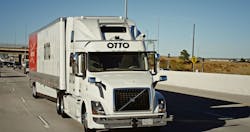So I sat through several interesting presentations regarding the future of autonomous trucks this week at the TU-Automotive Connected Fleets USA conference in Atlanta and perhaps the most striking takeaway from those discussions is that while autonomous trucks will be “self-driving,” they won’t truly ever be “driverless,” as the need for a human operator behind the wheel is never going away – though not for the reasons you think.
“The driver isn’t going anywhere,” explained Dan Murray, vice president with the American Transportation Research Institute (ATRI), which recently issued a report on autonomous truck trends.
“Drivers will still need to be on board to handle cargo loading and unloading, sign bills of lading, conduct pre- and post-trip inspections, and any number of other tasks,” Murray said, “The driver is critical; those tasks simply cannot be addressed alone by an autonomous truck.”
He added that this isn’t an “academic” discussion anymore, either, because in Murray’s words, “while I thought it would take 10 to 15 years to deploy such vehicles, they are now here today. In fact, an autonomous truck just recently hauled its first load of freight. So this technology is moving very fast.”
Yet of course there remain many hurdles to surmount – not the least of which will be the cost of the self-driving technology itself. Murray estimates that the price for a Class 8 truck, which can cost anywhere from $125,000 to $135,000 for a “basic model” today, will jump to around $200,000 with autonomous systems on board.
He noted, too, that trucking companies “are very savvy” in terms of achieving payback and typically expect a return on investment (ROI) of 12 to 18 months for new technology.
Can autonomous trucks deliver payback on such an ROI timeline?
Sandeep Kar, global vice president for research and mobility at Frost & Sullivan thinks so – primarily through providing drivers with a better work environment.
His research indicates that by 2022, driver benefits and wages will make up 31% of the total cost of operation (TCO) for a long-haul trucking fleet in the North America – topping the price tags for a tractor and trailer (12%) and even fuel (29%).
“It is now all about finding and keeping drivers and if you can provide technologies that make the job easier and allow them to connect with the outside world, with friends and family, they will respond to that – especially Millennials,” he said.
Something to keep in mind as more and more “autonomous loads” start hitting the road.

